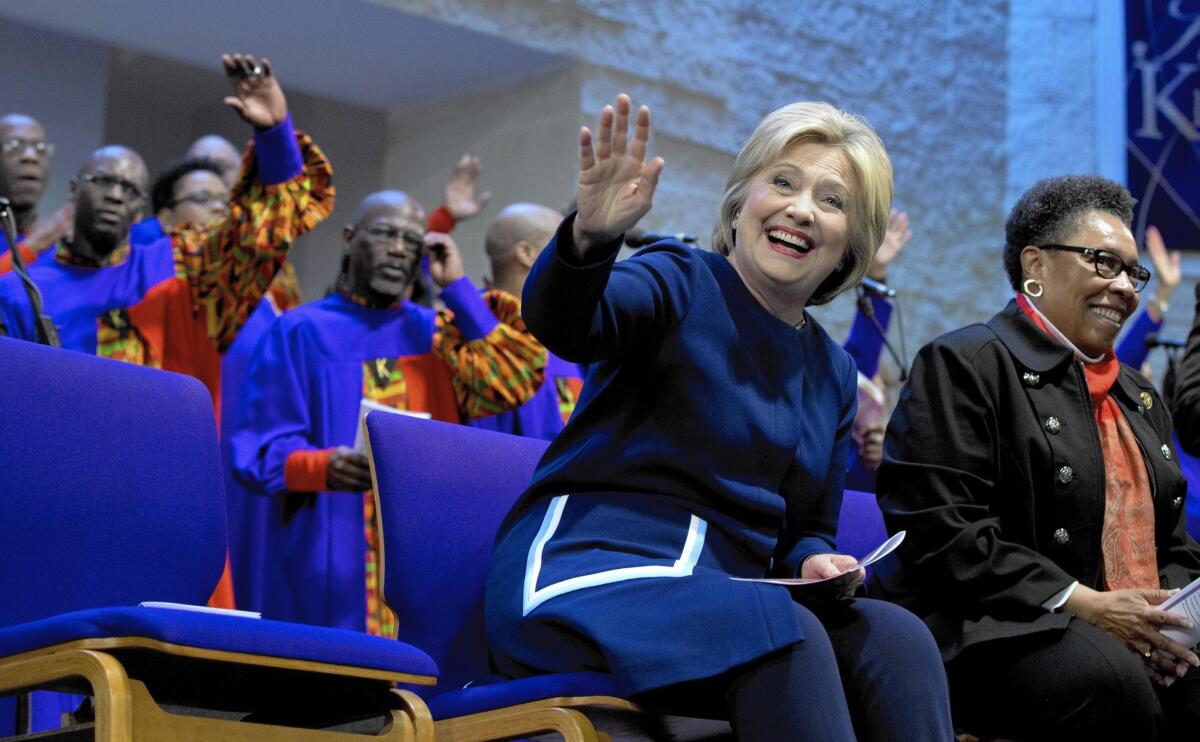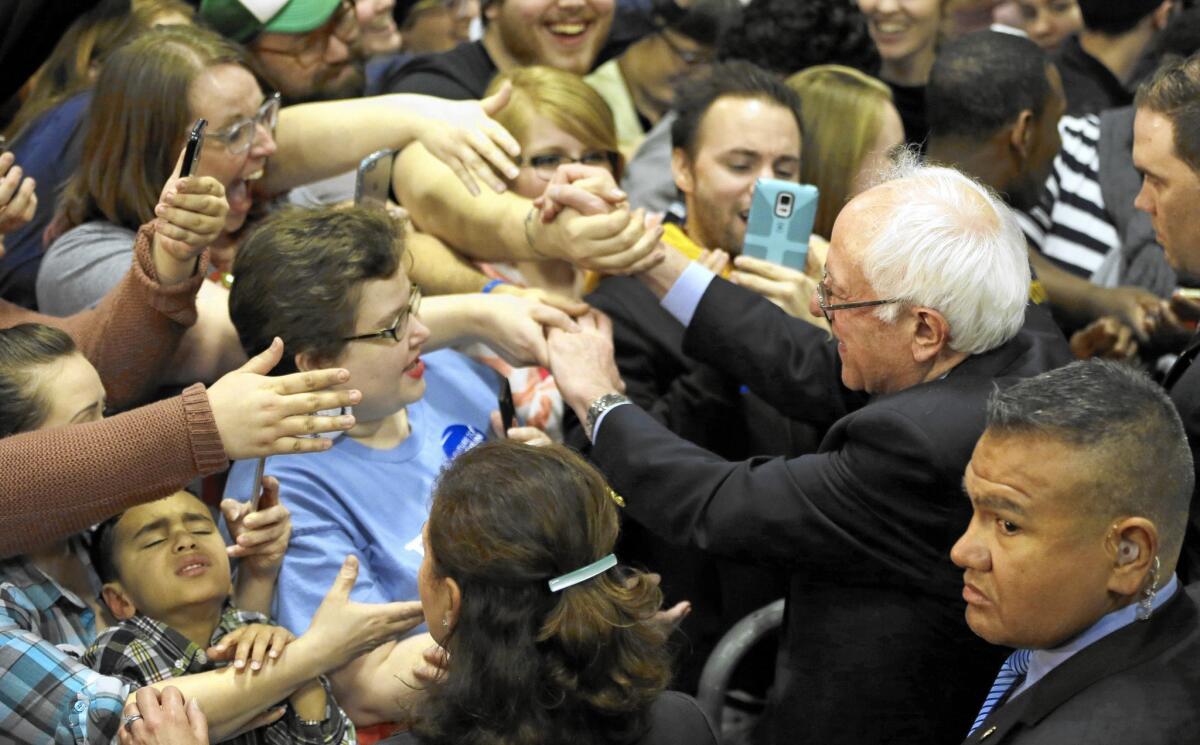‘Michigan on steroids’: Factors that will determine whether Clinton or Sanders win Ohio

Hillary Clinton with U.S. Rep. Marcia Fudge (D-Ohio) during a service at Mount Zion Fellowship Church in Highland Hills, Ohio, on March 13.
- Share via
Reporting from CLEVELAND — Through cities and suburbs, through isolated farmland and fractured steel towns, the Democratic presidential campaign has come to Ohio, whose verdict Tuesday will rest on an unpredictable mix of blue-collar anger, young voter enthusiasm and African American strength.
Hillary Clinton found sustenance here before, in a romping 2008 primary victory over Barack Obama, and she is counting on loyalty and the state’s Midwestern sensibility to help her dispatch this year’s opponent, Bernie Sanders.
Election 2016 | Live coverage on Trail Guide | March 8 election results | Track the delegate race | Sign up for the newsletter
Sanders is hoping to build on his victory last week in Michigan, a neighboring state where he came from behind on the strength of his vehement opposition to foreign trade, attracting working-class voters and significantly cutting into Clinton’s black support.
The question for both: Was Michigan a fluke or a tipping point?
The answer may rest on the conflict that has torn Democratic voters in all the early states, between one candidate who inspires and another who argues she can more effectively accomplish goals they share.
John Collier, a 21-year-old junior at Ohio State wearing a long-sleeved Buckeyes shirt, discussed the presidential campaign in a student lounge on the university’s Columbus campus. He admires Clinton, he said. But that’s not enough.
“I’ve heard it put before that Hillary Clinton is probably the most qualified candidate for the system that we have,” said Collier, who is studying economics. “Bernie Sanders is the most qualified candidate for the system we want to have.
“There’s nothing against Hillary Clinton,” he said. “I think she’s more qualified than any of the Republican candidates. But I think Bernie Sanders is the one that we need to elect if we want to see far-reaching progress.”

Vermont Sen. Bernie Sanders greets supporters after speaking at a campaign rally in Toledo, Ohio, on March 11.
Chase Ritenauer is the 31-year-old mayor of downtrodden Lorain, Ohio, one of a string of industrial towns extending from Toledo east to Cleveland along Lake Erie. There, Broadway Avenue marches toward City Hall in a mournful parade of closed or little-frequented businesses. Ritenauer, unlike most Democrats his age, is siding with Clinton.
In his town, he said, “people feel in America we’re not where we ought to be. We’re seeing job losses and want someone who’s going to stop that job loss and bring the jobs back home.”
“I like both of them,” Ritenauer said. “I like their positions and I will support the Democratic nominee. What separates her, to me, is that she’s been there.... I walk into the job every day saying, ‘How do I get things done?’ She’s in more of a position, given the things she’s talked about, to actually do them.”
In Ohio — a perennial general election powerhouse — the Democratic choice will play out amid pockets of economic improvement and malaise.
The Youngstown area where steel mills once reigned is now a hub for high-tech manufacturing, so much so that President Obama has cited it as a model in two State of the Union addresses. A steel plant in Canton that feeds the auto industry is booming. But its sister plant in Lorain, which relies on the health of the oil and gas industry, is struggling.
Overall the state has 200,000 fewer jobs than it did in 2000, when it hit peak employment, according to Policy Matters Ohio, a left-leaning policy research institute. In that time, median income has fallen 16%, along with hourly wages. The average income, just shy of $49,000 a year, is below the national average.
The state in October finally recovered the jobs lost in the Great Recession, about 18 months after most other states hit that mark.
“The overwhelming reason is the loss of manufacturing employment in Ohio,” said Amy Hanauer, the group’s executive director. Not all of that is due to foreign trade deals, she said, “but there’s no question that jobs have left Ohio for other countries.”
That plays directly into the case that Sanders is making as he blames job losses on deals including the North American Free Trade Agreement of the 1990s, backed by President Bill Clinton and Hillary Clinton, who believed it would open markets to U.S. manufacturers and create jobs. As Clinton and Sanders fought in Michigan, she acknowledged the deal had actually cost jobs.
For Sanders, it was only one of the centrist moves by both Clintons that he has criticized. But as in Michigan, trade has been his primary thrust in Ohio; ads running here assert that he’s the only candidate who can be counted on to back workers, a nod not only to Clinton’s support of NAFTA but also her work in the Obama administration on behalf of the Trans-Pacific Partnership deal. (She has since come out against that agreement.)
Trade is not a new topic in the state. One of the most vociferous opponents of NAFTA was Sherrod Brown, then a congressman from Lorain and now the state’s U.S. senator. (He is now a Clinton supporter; he said he has talked to her about trade issues and thinks she can effectively protect workers.)

How does the delegate process work, and why do we hear so much about them during the election? We broke down the process for you using Peeps. Track the delegate race and see also: The Iowa caucus explained using gummy bears For more, go to latimes.
“There’s really not an area of the state that hasn’t been touched” by job losses, said Jeff Rusnak, Sanders’ state campaign director. “If you look at Ohio, it’s the perfect state for Sen. Sanders. He really appeals to it because his message is so strong with the voters who have kind of been forgotten.
“Ohio in many ways is Michigan on steroids.”
Clinton started off with something of an advantage over Sanders, notably among the same voters he’s seeking.
In 2008, Ohio voted after Obama’s campaign roared to life, but it was Clinton who captured the state. She won those without college degrees — one of Sanders’ strongest groups now — by 18 percentage points and ran strongly among those at the lower end of the income scale. Among those who said trade had cost Americans jobs, she defeated Obama by 10 points.
But Sanders has leveled a far fiercer denunciation of Clinton’s trade positions than did Obama, who generally shared her views. That and the loss of even more jobs in the eight years since the last race pose the sharpest danger to Clinton now.
If Sanders continues to command young and liberal voters, Clinton is depending on the same mix of African American and suburban support that disappointed her in Michigan. Her campaign is running ads featuring the mothers of young African American men killed by police; in one, narrator Morgan Freeman casts Clinton as someone who has stood by the black community and the nation’s first black president, the man she defeated here.
The Clinton campaign is basing its hopes on the notion that Clinton will retain her 2008 supporters and — even more — that Ohioans want to look ahead, not relitigate the 1990s. She may also benefit from the fact that for all its jobs difficulty, the state is more conservative on the whole than Michigan, which has long had a weakness for liberal lightning rods.
Rep. Tim Ryan has represented some of the more grievously hit areas of Ohio for 14 years. Enough with the NAFTA fight, he said.
“I really don’t want to have a conversation about NAFTA,” said Ryan, a Clinton supporter. “I want to have a conversation of what we do now.
“We know what the problem is, but at the end of the day we want someone who has a detailed, sophisticated plan, who’s going to help us grow.... I don’t see any of that coming out of Bernie’s campaign.”
Such pragmatism doesn’t sell with Sanders voters like Morgan Johnson, the state director of College Students for Bernie.
“Hillary has done some amazing things and she’s really had a terrific career,” said Johnson, who is 21 and hoping to go to law school. “But I like that Bernie is talking about reaching for the stars to at least get to the moon.
“I don’t feel comfortable with somebody basing policy off of, ‘Here’s the base line, here’s what we can do,’” Johnson said. “Whereas Bernie is calling to ask us what is possible, asking what is possible here and then working for those.”
Twitter: @cathleendecker
Twitter: @markzbarabak
Decker reported from Cleveland and Barabak from Columbus.
ALSO
Delegate tracker: Who’s winning the race to the nomination?
Donald Trump casts a big shadow in the Democratic race too
Trump’s businesses would create unprecedented challenges in the White House
More to Read
Get the L.A. Times Politics newsletter
Deeply reported insights into legislation, politics and policy from Sacramento, Washington and beyond. In your inbox twice per week.
You may occasionally receive promotional content from the Los Angeles Times.












